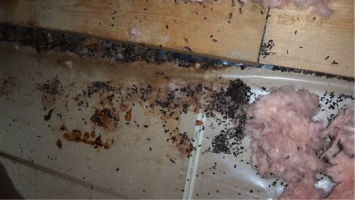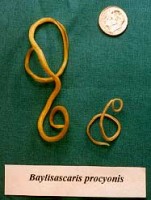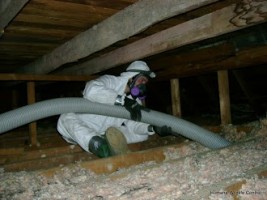When wildlife takes up residence inside your home it can be pretty stressful for you and your family. For most people, the immediate concern is removing the animals and preventing them from getting back in.
Getting rid of troublesome raccoons, squirrels, birds, bats, mice and skunks from your home or property is only part of the battle. Once they’re gone, it’s important to inspect the infected areas in search of what they’ve left behind.

Wildlife can leave behind large amounts of droppings, urine, hair, oils, food, nesting material, and so on. These remnants can attract insects like cockroaches, and the scent left behind can encourage new animals to attempt to chew or break their way into your house. You might also experience odor problems from the waste. It’s possible or likely that mold will grow on the areas of feces and urine, and urine can damage wood or sheetrock. Some of the mold can potentially cause diseases that people can catch, and some of the feces themselves can cause diseases, such as Salmonella or Leptospirosis, and raccoon feces can contain roundworm eggs, which can infect people.
The level of damage and contamination left behind by a wildlife infestation depends on a number of factors. The type of species involved, where they’ve been living and how long they’ve been living there will all play a role.
Possible diseases that could cause you harm if not sanitized:

- Baylisascaris procyonis aka raccoon roundworm, is increasingly recognized as a cause of serious or disease in humans and animals. The parasite can cause severe human neurological disease if ingested. A key feature of the epidemiology of baylisascariasis is the behavior of raccoons. Raccoons habitually defecate in communal sites called latrines. The locations of latrines are associated with various natural and human-made structures like attics and chimneys. Racoons shed millions of the microscopic roundworm eggs in their feces. People may encounter the eggs through direct contact with raccoon droppings or by touching a contaminated area or object. If they don’t wash their hands they may later transfer the eggs to their mouths. Young children are especially at risk for infection because of their propensity to handle objects and put them in their mouth.
- Histoplasmosisis a respiratory disease that may be fatal. It results from a fungus growing in dried bird, bat or mouse droppings.
- Cryptococcosis is caused by yeast found in the intestinal tract of pigeons and starlings. The illness often begins as a pulmonary disease and may later affect the central nervous system. Since attics, ledges, schools, offices, warehouses, mills, barns, park buildings, signs, etc. are typical roosting and nesting sites, the fungus is apt to found in these areas.
- E coli. Cattle carry E coli 0157:H7. When birds peck on cow manure, the E. coli go right through the birds and the bird droppings can land on or in a food or water supply.
- Louis Encephalitis, an inflammation of the nervous system, usually causes drowsiness, headacheand fever. It may even result in paralysis, coma or death
- Leptospirosis and salmonella are both deadly diseases carried in squirrel droppings. Squirrels are also vectors for a variety of external parasites which can cause secondary infection in people for diseases such as Lyme disease
- Campylobacter(meaning “curved bacteria”) is a genus of Gramnegative nonfermentative bacteria. Campylobacter species are typically spiral-shaped and able to move via unipolar or bipolar flagella. MostCampylobacter species are pathogenic and can infect humans and other animals. At least a dozen species of Campylobacter have been implicated in human deaths. jejuni is now recognized as one of the main causes of bacterial foodborne disease in many developed countries.
How to clean up your attic after an animal infestation:
ASSESS AND REMOVE
The first step in our process involves a specialized assessment by one of our trained and experienced Wildlife Technicians. They go where the animals go to determine the level of contamination and damage that exists inside your attic. Our technicians will assess the quality of your insulation and building materials and provide recommendations for repair.
CLEAR AND CLEAN
Employing the industry’s leading techniques and equipment, like powerful trade vacuums and advanced breathing equipment, our equipped technicians make it priority to clear contaminated materials from your home and return it to a healthy, livable state.

The cleanup process:
- Remove all damaged/soiled insulation
- Clean all latrines
- Vacuum and sanitize
- Double bag and remove debris
- Reinsulate back to code
- We remove or vacuum all droppings, or remove all the soiled insulation.
- We fog the attic with a special enzyme-based cleaner that destroys any organic matter and deodorizes the space.
- We repair damage, such as ductwork, vents, insulation, and more.
Homeowners should place a high priority on re-constructing the attic after an infestation to avoid it from happening again. If the animals found a way in the first time, and that entry point isn’t sealed, more animals will come in and contaminate the space again.
Skedaddle Humane Wildlife Control
Sometimes the damage and destruction left behind by wildlife can be worse than the infestation itself. The best way to avoid unnecessary repairs is to hire a professional wildlife removal company to deal with the problem immediately. The longer you wait the worse it could get. Skedaddle Humane Wildlife Control specializes in cleaning up what wildlife leaves behind and has been trusted by homeowners in since 1989.
Call Skedaddle Humane Wildlife Control today. 1-877-222-9453
Proudly serving: Ottawa, Montreal, Halifax, Hamilton, Burlington, Oakville, Mississauga, Brampton, Kitchener-Waterloo, Guelph, Sudbury, St. Catharine’s, Cambridge and the Niagara Region.


